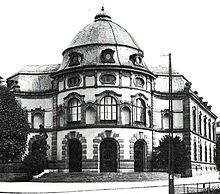Emanuel La Roche
Rudolf Emanuel La Roche (born January 17, 1863 in Ziefen ; † July 1, 1922 in Celerina ) was a Swiss architect .
biography
La Roche was born in Ziefen ( Canton Basel-Landschaft ) in 1863 as the son of a pastor. In 1871, when La Roche was eight years old, the family moved to Basel , where his father took the position of curator of the museum on Augustinergasse. His path to architecture also led through his father, whom he initially supported with carpentry and stone carving work as well as with research into the history of the cathedral; he also attended lectures by Jacob Burckhardt , e. B. on the history of modern Italian art. From 1882 to 1884 La Roche studied at the Polytechnikum Stuttgart a . a. with Christian Friedrich von Leins . In 1886 he put in a year of practice in a sculptor's studio in Strasbourg and in an architecture office in Mannheim , before working in Florence in 1887 as a collaborator on Heinrich von Geymüller's publication The Architecture of the Renaissance in Toscana . From 1889 to 1890 he accompanied the banker Alfred Sarasin-Iselin on his trip to the Orient to Egypt, India, Athens and Constantinople.
After returning to Basel, he worked on some sculptural works (bronze doors of the Galluspforte at Basel Minster, collaboration on Adolf von Hildebrand's fountain on Maximiliansplatz in Munich ) before completing his first building, Alfred Sarasin's house, in 1892.
As early as 1893, he was commissioned to build the Basel University Library on Bernoullistrasse, which was completed in 1896. At the same time, he built a total of eight commercial buildings on Freie Strasse by 1902. In addition, he carried out some orders abroad. He worked in Vienna from 1894 to 1896 , where he built a mausoleum, the Faniteum . In later years La Roche was involved with other architects in other important buildings in Basel, such as B. at the music academy together with Fritz Stehlin and at the station building together with Emil Faesch . During the First World War, La Roche received only a few orders and worked with Fritz Stehlin on sketches for possible building projects, including an art museum on Münsterplatz and a university building on Petersplatz.
His early work can be classified in the lush New Baroque and Neo-Renaissance styles, while his later works can be assigned to a more moderate New Baroque and partly to the Art Nouveau .
La Roche died in the summer of 1922 while on vacation in Celerina in Graubünden.
See also
- Rudolf Linder (1849–1928), Basel architect who shaped the city at the same time
literature
- Rose Marie Schulz-Rehberg : Architects of the Fin de Siècle: Building in Basel around 1900 . Christoph Merian Verlag, Basel 2012. ISBN 978-3-85616-527-7
- Hans Georg Oeri: The bronze doors at the Galluspforte of Basel Minster . In: Basler Zeitschrift für Geschichte und Altertumskunde . Vol. 100, 2000, pp. 193-205. ( e-periodica.ch )
Web links
- Romana Anselmetti: La Roche, Emanuel. In: Historical Lexicon of Switzerland .
- Emanuel La Roche. In: Architects Lexicon Vienna 1770–1945. Published by the Architekturzentrum Wien . Vienna 2007.
- Works by Emanuel La Roche in the digital collections of the Stuttgart University Library .
Individual evidence
- ↑ Sarasin, Alfred (1865–1953) on kalliope-verbund.info
| personal data | |
|---|---|
| SURNAME | La Roche, Emanuel |
| ALTERNATIVE NAMES | La Roche, Rudolf Emanuel |
| BRIEF DESCRIPTION | Swiss architect |
| DATE OF BIRTH | January 17, 1863 |
| PLACE OF BIRTH | Ziefen |
| DATE OF DEATH | July 1, 1922 |
| Place of death | Celerina |


